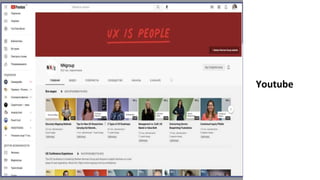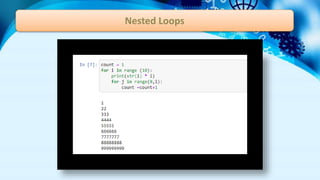Ad
Advance Python programming languages-Simple Easy learning
- 2. Amazon
- 5. Dropbox
- 6. Uber
- 7. Instagram
- 8. Youtube
- 9. WHAT IS PYTHON 9 • Python is a popular programming language. • It was created by Guido van Rossum, and released in 1991. • It is used for: ⮚web development (server-side). ⮚software development. ⮚mathematics. ⮚system scripting.
- 10. WHY PYTHON IS WIDELY USE? 10 • The python language is one of the most accessible programming languages • Python works on different platforms (Windows, Mac, Linux etc). • Python has a simple syntax. • Python is easy to code. • Python runs on an interpreter system, meaning that code can be executed as soon as it is written. • Python is a object Oriented Programming Language
- 11. IDE – FOR PYTHON 11 • Jupyter IDE can be use for python coding. • Jupyter is a free, open-source, interactive web tool that allows editing and running files via a web browser. • To launch a Jupyter notebook, open your terminal and navigate to the directory where you would like to save your notebook. • Then type the command Jupyter notebook and the program will instantiate a local server at localhost:8888
- 12. ALGORITHM The step by step procedure to solve an identified problem is called an algorithm.
- 13. ALGORITHM • PRINT 1 TO 20 STEPS STEP 1:Initialize X as 0 STEP 2:Increment X by 1 STEP 3:Print X STEP 4:If X is less than 20 then go back to step 2
- 14. ALGORITHM
- 15. FLOWCHART • A flowchart is the graphical or pictorial representation of an algorithm with the help of different symbols, shapes and arrows in order to demonstrate a process or a program.
- 17. ALGORITHM • Convert temperature from Fahrenheit to Celsius
- 18. PROGRAM • A computer program is a collection of instructions that perform a specific task when executed by a computer. • Examples- BASIC, Java, C, C++, Ruby, Python, Pascal etc.
- 19. Why Python for AI? • Easy to learn, read and maintain • A broad standard library • Interactive mode • Portability and compatibility • Extendable • Databases and scalable
- 20. BASIC PROGRAMMING SYNTAX 20 • Python syntax are very much simple and easy. • Every programming language has its own set of rules that make up its basic syntax. • Hence ,it’s easy to code in Python. For Example: print(“ Learn from PodarPearl “) • The syntax mention above is the basic syntax of python programming language to print .
- 21. PYTHON KEYWORDS 21 • A keyword is a word having special meaning reserved by programming language. • We cannot use a keyword as a variable name, function name or any other identifier.
- 23. Integrated Development Environment(IDE) edit run browse debug • Cross-platform programming language-Windows, Mac OS, Linux. • IDLE(GUI integrated) is the standard and popular python development environment.
- 24. Python shell – used in 2 ways: Interactive mode Allows us to interact with OS Script mode Lets us create/edit source file
- 25. Python script/program • Python statements written in a particular sequence to solve a problem is known as Python script/program.
- 27. Introduction to tools for AI ANACONDA 3 • Free open source distribution of python language Data science OWN PACKAGES ML OWN SETTINGS Predictive analytics Large scale data processing DIFFERENT VIRTUAL ENVIRONMENTS
- 28. Anaconda navigator • Is a desktop GUI included in Anaconda that allows you to launch applications and easily manage conda packages, environments and channels without the need to use command line commands. What did we install? • Anaconda prompt – Anaconda’s Command line Interface(CLI) : is a Python CLI where we can create different virtual environments and install packages into them as per our need.
- 29. Jupyter Notebook • Powerful tool for interactively developing and presenting AI related projects. • Possible to use different programming languages • Python is commonly used language in it. NOTEBOOK It integrates codes and its output into a single document that combines visualisations, narrative text, mathematical equations. Data science, analysis and science.
- 30. Working with Jupyter notebook • KERNEL – provides programming language support in Jupyter. • Default kernel = IPython conda.install jupyter nb_conda ipykernel jupyter notebook
- 31. Program 1
- 32. Program 2
- 33. Program 3
- 34. Multi line statements Statements can be extended to one or more line using -
- 35. Python statement and comments • Instructions written in the source code for execution are called statements. • Different types - 1. Assignment statement 2.Conditional statement 3.Looping statement
- 36. Python comments - # It doesn’t affect the outcome of the code.
- 37. LIST OF KEYWORDS
- 38. KEYWORDS & IDENTIFIERS • Keywords – are the reserved words in python used by python interpreter to recognize the structure of the program. • Identifier – is a name given to the entities like class, variables, functions etc. It helps to differentiate one entity from another. • (Entity is a python library for automated object validation and serialization)
- 40. VARIABLES • A variable is a named location used to store data in the memory. • X = 42 • Y = 42
- 41. DATA TYPES • All data values are represented by objects. • Defines the operations possible on the variables and their storage method. NUMERIC LIST SET TUPLE STRING DICTIONARY
- 42. 1.NUMERIC • Stores numeric values • Immutable Integer type 11 Complex type 10+6j Float type 6.24
- 43. 2.LIST • Store elements of different types • Most versatile type in python States = [‘Punjab’ , ‘Haryana’ , ‘Rajasthan’, 28] print(States)
- 44. 3.TUPLES • It’s a sequence of immutable python objects. • Faster than lists • If a constant set of values is to be defined which we must iterate – use tuple • Cannot update, add, delete an element Grade = ( ‘Einstein’ , ‘Newton’ , ‘Darwin’)
- 45. 4.STRINGS • Characters are enclosed in quotes- single /double. S = ‘Welcome to ISS’ D = “Strings”
- 46. 5.SET • Collection of items without any specific order. • Every element is unique. • Union, Intersection , Difference, Symmetric difference Set_1 = {7,8,9} Set_2 = {3,6,6,7}
- 47. 6. DICTIONARY • Contains key value pairs enclosed within curly braces and keys and values are separated by ‘:’ Dict = {‘Name’ : ‘Karthik’ , ‘Age’ : 20}
- 49. COMPARISON OPERATOR Operator Description Example == If the values of two operands are equal, then the condition becomes true. (A==B) is not true != If the values of two operands are not equal, then the condition becomes true. (A!=B) is true > If the value of left operand is greater than the value of right operand, then the condition becomes true. (A>B) is true < If the value of left operand is less than the value of right operand, then the condition becomes true. (A<B) is not true >= If the value of left operand is greater than or equal to the value of right operand, then the condition becomes true. (A>=B) is true <= If the value of left operand is less than or equal to the value of right operand, then the condition becomes true. (A<=B) is not true
- 50. ASSIGNMENT OPERATOR Operator Description Example = Assigns values from right side operands to left side operand C =A+B += Add AND It adds right operand to the left operand and assigns the result to left operand C +=A -= Subtract AND It subtract right operand to the left operand and assigns the result to left operand C -=A *= Multiply AND It multiplies right operand to the left operand and assigns the result to left operand C*=A /= Divide AND It divides left operand by right operand and assigns the result to left operand C/=A %= Modulus AND It takes modulus using two operands and assigns the result to left operand C%=A **= Exponent AND It performs exponential (power)calculation on operators and assigns value to the left operand C**=A
- 51. OPERATOR EXAMPLE Addition A+B = 300 Subtraction A-B = -100 Multiplication A*B = 20000 Division A/B = 0.5 Modulus B%A = 0 Exponent A**B = 100 to the power of 200
- 52. LOGICAL OPERATORS OPERATOR DESCRIPTION EXAMPLE and True ,if both the operands are true X and Y or True, if either of the operands is true X or Y Not True , if operand is false not X
- 53. MEMBERSHIP OPERATORS OPERATOR DESCRIPTION EXAMPLE in True , if value/variable is found in the sequence 5 in x not in True , if value/variable is not found in the sequence 5 not in x
- 54. IDENTITY OPERATORS OPERATOR DESCRIPTION EXAMPLE is True, if the operands are identical X is True is not True , if the operands are not identical X is not True
- 55. X Y X and Y True True True True False False False True False False False False and
- 56. X Y X or Y True True True True False True False True True False False False or
- 57. X not X True False False True not
- 58. if elif else If X<Y else X=Y elIf X>Y Statements_a Statements_c Statements_b Rest of the code Start False False True True
- 59. Example :
- 60. PYTHON LOOPS Infinite loop Finite loop Never become false Become false
- 61. While Loop • The condition is checked and if it is true, control will move inside the loop and execute the statements until the condition becomes false. • When we are unsure about the number of iterations
- 62. While Loop
- 63. For Loop • The number of iterations is defined.
- 64. Nested Loops • A loop within a loop. • For loop inside a while loop or the other way round. • For loop inside a for loop. • While loop inside a while loop.
- 65. Nested Loops
- 66. Python Functions Uses : 1. Code reusability 2.Code organization and documentation 3.Abstraction 4.Extensibility and Scalability










































![2.LIST
• Store elements of different types
• Most versatile type in python
States = [‘Punjab’ , ‘Haryana’ , ‘Rajasthan’, 28]
print(States)](https://image.slidesharecdn.com/ixaiunit4advancepython1-240427152751-d1113199/85/Advance-Python-programming-languages-Simple-Easy-learning-43-320.jpg)













































































